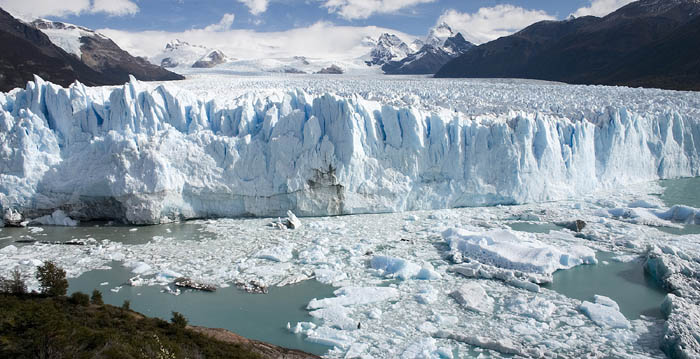
The most comprehensive and accurate analysis to date shows that almost all the world’s glaciers are becoming thinner and losing mass and that these changes are picking up pace.
Glaciers are a sensitive indicator of climate change – and one that can be easily observed. Regardless of altitude or latitude, glaciers have been melting at a high rate since the mid-20th century. Until now, however, the full extent of ice loss has only been partially measured and understood. A paper published in Nature this week provides the first comprehensive study of global glacier retreat.
It includes all the world’s glaciers — about 220,000 in total — except for the Greenland and Antarctic ice sheets.
Rising sea levels and water scarcity
What was once permanent ice has declined in volume almost everywhere around the globe. Between 2000 and 2019, the world’s glaciers lost a total of 267 billion tonnes of ice per year on average — an amount that could have submerged the entire surface area of Switzerland under six meters of water every year. The loss of glacial mass also accelerated sharply during this period. Between 2000 and 2004, glaciers lost 227 billion tonnes of ice per year, but between 2015 and 2019, the lost mass amounted to 298 billion tonnes annually.
Glacial melt caused up to 21 percent of the observed rise in sea levels during this period – some 0.74 millimeters a year. Nearly half of the rise in sea levels is attributable to the thermal expansion of water as it heats up, with meltwaters from the Greenland and Antarctic ice sheets and changes in terrestrial water storage accounting for the remaining third.
Among the fastest melting glaciers are those in Alaska, Iceland and the Alps. The situation is also having a profound effect on mountain glaciers in the Pamir mountains, the Hindu Kush and the Himalayas.
“The situation in the Himalayas is particularly worrying,” explains lead author Romain Hugonnet. “During the dry season, glacial meltwater is an important source that feeds major waterways such as the Ganges, Brahmaputra and Indus rivers. Right now, this increased melting acts as a buffer for people living in the region, but if Himalayan glacier shrinkage keeps accelerating, populous countries like India and Bangladesh could face water or food shortages in a few decades.”
(Adapted from materials provided by ETH Zurich)
| Abstract of Romain Hugonnet al., “Accelerated global glacier mass loss in the early twenty-first century,” Nature 592, April 28, 2021
Glaciers distinct from the Greenland and Antarctic ice sheets are shrinking rapidly, altering regional hydrology, raising global sea level and elevating natural hazards. Yet, owing to the scarcity of constrained mass loss observations, glacier evolution during the satellite era is known only partially, as a geographic and temporal patchwork. Here we reveal the accelerated, albeit contrasting, patterns of glacier mass loss during the early twenty-first century. Using largely untapped satellite archives, we chart surface elevation changes at a high spatiotemporal resolution over all of Earth’s glaciers. We extensively validate our estimates against independent, high-precision measurements and present a globally complete and consistent estimate of glacier mass change. We show that during 2000–2019, glaciers lost a mass of 267±16 gigatonnes per year, equivalent to 21±3 per cent of the observed sea-level rise6. We identify a mass loss acceleration of 48±16 gigatonnes per year per decade, explaining 6 to 19 per cent of the observed acceleration of sea-level rise. Particularly, thinning rates of glaciers outside ice sheet peripheries doubled over the past two decades. Glaciers currently lose more mass, and at similar or larger acceleration rates, than the Greenland or Antarctic ice sheets taken separately. By uncovering the patterns of mass change in many regions, we find contrasting glacier fluctuations that agree with the decadal variability in precipitation and temperature. These include a North Atlantic anomaly of decelerated mass loss, a strongly accelerated loss from northwestern American glaciers, and the apparent end of the Karakoram anomaly of mass gain. We anticipate our highly resolved estimates to advance the understanding of drivers that govern the distribution of glacier change, and to extend our capabilities of predicting these changes at all scales. Predictions robustly benchmarked against observations are critically needed to design adaptive policies for the local- and regional-scale management of water resources and cryospheric risks, as well as for the global-scale mitigation of sea-level rise. |


